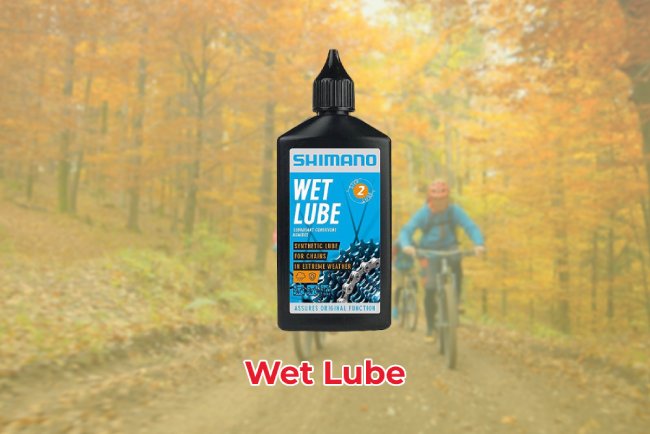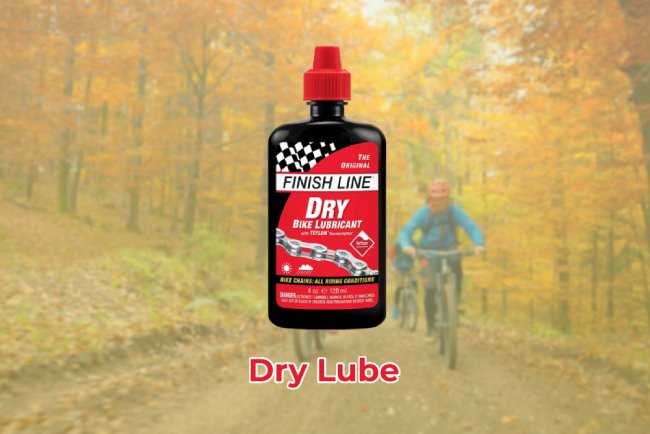The rules are simple:
- Wet lubes for wet weather
- Dry lubes for dry weather
- Both for variable conditions but you’ve to deal with gunk on your drivetrain on dry days
Since dry lubes are much thinner, you’ve to reapply quite often. On the other hand, wet lubes are heavier and don’t wash off easily by rain, but they catch a lot of dirt.
Let’s get to know more about wet and dry lubes and how exactly they differ.
Wet lube
Wet lubes are usually made of synthetic esters and anti-corrosive additives that suit wet conditions like humid environments and wet and muddy places.
They have a high viscosity level so they can repel water easily. Their water resistance capacity and stickiness work together to last longer.
Their biggest benefit is you don’t need to reapply frequently but the greatest drawback is they’ll catch a lot of dirt when it’s dry outside.
Dry lube
Dry lubes contain graphite and molybdenum disulfide. These components themselves aren’t dry and take some time to dry out upon application.
These lubes don’t gather dirt but they easily wash off as soon as they make contact with water. This means you’ve to reapply on a regular basis that some bikers aren’t very fond of.
In some cases, you’ve to make it as part of your pre-ride prep.
Wet Lube vs Dry Lube: Head-To-Head Comparison
| Comparing factors | Wet lube | Dry lube |
| Material | Synthetic esters and anti-corrosive additives | Graphite and molybdenum disulfide |
| Thickness | More thick | Less thick |
| Viscosity | High | Low |
| Using condition | Wet, muddy, and humid conditions | Dry conditions |
| Waiting time | No waiting time required | Needs some time to dry after application |
| Lasting time | Longer lasting | Doesn’t last long |
| Water resistance | Resistant | Not resistant |
| Dirt collection | Doesn’t collect dirt, sand and grime | Collects dirt and grime |
| Preferred season | Winter | Summer |
| Limitation | Shouldn’t be used in dry or dusty areas | Shouldn’t be used in wet places |
| Maintenance | Less | High |
| Price | Less expensive | More expensive |
Material
Wet lube
They are mainly composed of synthetic esters and anti-corrosive additives that have high water resistance capability, which makes the lube perfect for wet conditions and gives the chain drive long-lasting protection from rust and wear.
Dry lube
Dry lubes contain graphite and molybdenum-disulfide that work at temperatures higher than those in which oil-or liquid-based lubricants operate. Friction-reducing additives such as Teflon (PTFE) are also often used for better results.
Viscosity
Wet lube
Wet lubes have higher viscosity levels than dry lubes that makes them thicker to repel water more effectively.
Dry lube
The major components of dry lubes – molybdenum disulfide and graphite – have low-friction characteristics that can operate at 350 degrees C in an oxidizing atmosphere while the solid molybdenum disulfide can handle as much as 1100 degrees C.
Weather
Wet lube
Wet lubes are designed for wet and muddy conditions. Wet springs, fall, and winter are the perfect time to use them.
However, You can use them in dry conditions too if you’ve to deal with rain and humidity on summer days.
Dry lube
You should not use dry lubes in winter as they excel in dry conditions only because of being thinner and waxy.
When to use
Wet lube
You can consider using a wet lubricant if you’re covering long-distances so an unexpected rain doesn’t hamper your ride.
If you are lazy like me or forget to lube your bike timely then wet lubes are your only solution. You’ll also love them if your chain is noisy.
Dry lube
Since dry lubes don’t stay long on chains, you’ve to be prepared to lubricate your bike more often.
But beginner bikers will find them useful since these lubes are low-maintenance and don’t attract dirt and grime that much.
Waiting time after application
Wet lube
Wet lubes are meant to be wet when you hit the street. So, you don’t need to wait for them to set properly on the chain and can use your bike instantly after application; even in the middle of your ride.
Dry lube
Dry lubes are initially wet when applied but dry out usually in a couple of hours. This means you can’t use your bike instantly once you apply them.
Lasting time
Wet lube
Wet lubes last over 100 miles and some premium brands guarantee a range of up to 200 miles though road and weather conditions play a big role here.
Dry lube
Dry lubes usually last 100 miles at most while wax lubes are known to serve 50 to 100 miles.
Maintenance
Wet lube
Highly sticky in nature, wet lubes act like a dirt-, sand-, and grime-magnet. You’ll find it tough to keep your chain and drivetrain clean for long.
As a result, bikes that use wet lubes need more frequent cleaning.
Dry lube
As said before, dry lubes are beginner-friendly since they keep the bike free of dirt and gunk.
Price
Wet lube
Wet lubes came into the market before dry lubes and they are less costly.
Dry lube
Dry lubes are more expensive than wet lubes.
Advantages and disadvantages of wet lubes
Pros
- Best for wet, muddy, and humid conditions
- Lasts longer on chain
- No waiting time
- Less costly
- Reduces friction and noise
Cons
- High viscosity
- Collects dirt and grime easily
- High maintenance
Advantages and disadvantages of dry lube
Pros
- Works best in dry environments
- No seasonal restrictions
- Low viscosity
- Doesn’t collect dirt
- Low maintenance
Cons
- Long waiting time
- Doesn’t last long
- More expensive
Some Other Types of Lubes
1. All-weather lubes
These lubes are a mix of dry and wet lubes. So, they have all the benefits and disadvantages of wet and dry lubes and can be used in all seasons without any restrictions.
2. Wax
They are paraffin-based and manufactured by mixing highly refined paraffin with Teflon (PTFE) and a carrier fluid. They gained a lot of popularity in recent years for their efficiency, longevity, and resistance to contaminants.
3. Ceramic lubes
Although their composition is still unknown, it is said that they contain ceramic particles to reduce the friction of synthetic oils that are present in lubes and thus increase the performance of your bike and the longevity of your drivetrain.
Ceramic lubes are generally more expensive than other types of bike chain lubes.









